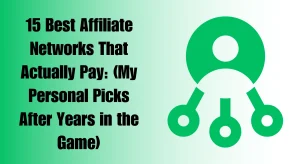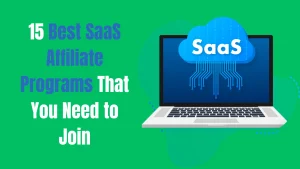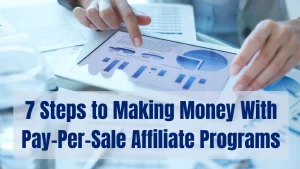10 Best Pay-Per-Click Affiliate Marketing Programs That Actually Pay Well

Can you really make money with PPC affiliate programs, or are they just another overhyped model?
With so many affiliate programs out there, most marketers focus on the pay-per-sale model, where you only earn if someone buys through your link. It works, but it has one major flaw: sales aren’t guaranteed.
That’s where pay-per-click (PPC) affiliate programs flip the script. Instead of waiting for a sale, you earn a commission every time someone clicks your link. No need to convince them to buy, no abandoned carts, no stress over low conversions. Just traffic that pays.
Sounds great, right? But there’s more.
Not all PPC programs are worth your time. Some pay cents per click, while others have high earning potential but strict traffic requirements. Worse, some programs push spammy ads that drive away your audience instead of engaging them.
That’s why choosing the right PPC programs is crucial. The best ones offer:
- Competitive payouts – So you don’t need massive traffic to make real money.
- Reliable tracking – So every valid click gets counted (no shady reporting).
- High-quality ads – So your audience engages instead of bouncing.
If you pick the wrong one, you’re passing up smarter opportunities. But the right one? It can be a steady, passive income stream—with clicks turning into cash every single day.
In this post, I’ll break down the best pay-per-click affiliate marketing programs that actually pay well. These aren’t random choices—they’re tested, trusted, and built for serious earnings.
How Pay-Per-Click Affiliate Programs Work
Most affiliate programs only pay when someone buys something through your link. That’s great—until you realize how many people click but never buy.
This is where PPC affiliate marketing does the heavy lifting. Instead of waiting for a sale, you earn instantly when someone clicks on an ad or affiliate link. No conversions needed. Just clicks.
Here’s how it works:
- You join a PPC affiliate program and get unique tracking links or ad placements.
- You place these ads on your website, blog, or social media.
- Every time someone clicks, you get paid—even if they don’t buy anything.
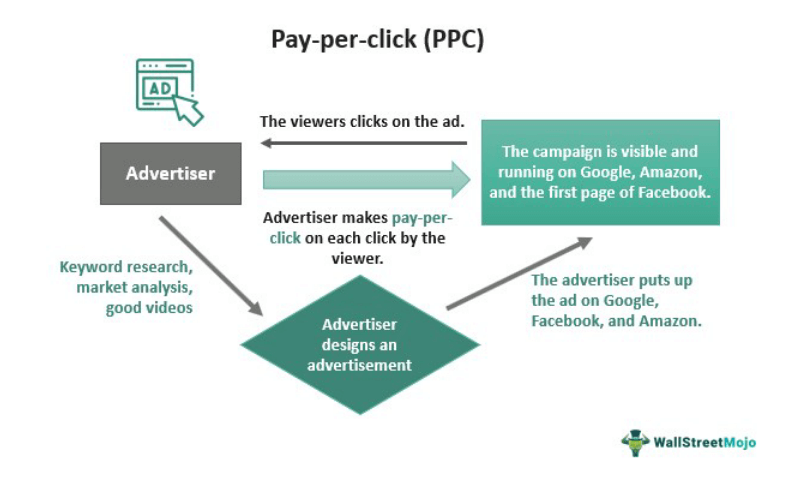
It sounds easy, but not all PPC programs pay the same. Some give pennies per click, while others pay a few dollars, depending on the niche. This is why choosing the right program matters.
Different PPC Models & How They Pay
Not all PPC programs follow the same structure. Some pay per click, others per thousand views, and some mix PPC with performance-based commissions.
- Cost Per Click (CPC) – The most common model. You earn a set amount per click. The payout depends on the niche and advertiser demand.
- Cost Per Mille (CPM) – You get paid per thousand ad impressions, even if no one clicks. Works best for sites with high traffic but low engagement.
- CPA Hybrid Models – You earn per click, but if the user signs up or takes action, you get a bonus commission. This is common in software and finance niches.
- SmartLink Ads – Instead of promoting a single link, these programs rotate high-converting offers based on user location and behavior. High engagement leads to higher earnings.
The highest-paying programs often combine these models, especially in industries like finance, SaaS, and insurance.
Why PPC Affiliate Marketing Works (And Where It Fails)
PPC affiliate marketing has some real advantages, but it also comes with challenges that can make or break your earnings.
Why It Works:
- Fast earnings without waiting for sales.
- Works well in high-traffic niches like finance, tech, and insurance.
- You can scale with paid ads if the margins are right.
- No need for lengthy sales funnels—just drive clicks and earn.
Where It Fails:
- Some programs pay too little to make it worthwhile.
- Many networks have strict traffic quality requirements.
- Earnings can fluctuate depending on ad budgets and demand.
- Click fraud and bot traffic can get your account banned.
- Some networks delay or withhold payments, making it risky.
PPC affiliate marketing is a strong option for those who pick the right programs. Some will barely cover small expenses, while others can bring in steady income. In the next section, I’ll break down the best PPC affiliate programs that actually pay well.
Here’s a refined and naturally flowing version of that section, following your tone and structure:
What to Look for in a Good PPC Affiliate Program
Not every PPC program is worth your time. Some offer dirt-cheap payouts, overload you with rules, or delay payments for months.
They’ll burn your traffic and waste your effort. The good ones? They’re clean, easy to use, and actually reward you for sending quality clicks. They respect your hustle and pay on time—no games.
Here’s what you should look at:
- Decent earnings per click. Avoid programs that pay less than $0.01. You’re not running a charity.
- Solid tracking and fast payouts. You need to trust the system. If clicks go missing or payments are late, walk away.
- Low payout threshold. Waiting to hit $100 before you get paid isn’t it. Look for $10–$50 minimum.
- Reputable advertisers. If the landing pages look shady or confusing, your traffic won’t convert.
- Consistent offers. You want programs that stick around. Not random campaigns that vanish in a week.
Choosing the right PPC program sets the tone for everything else. Weak programs bleed time. Strong ones pay while you sleep.
10 Best Pay-Per-Click Affiliate Marketing Programs
Let’s dive in…
1. Google AdSense
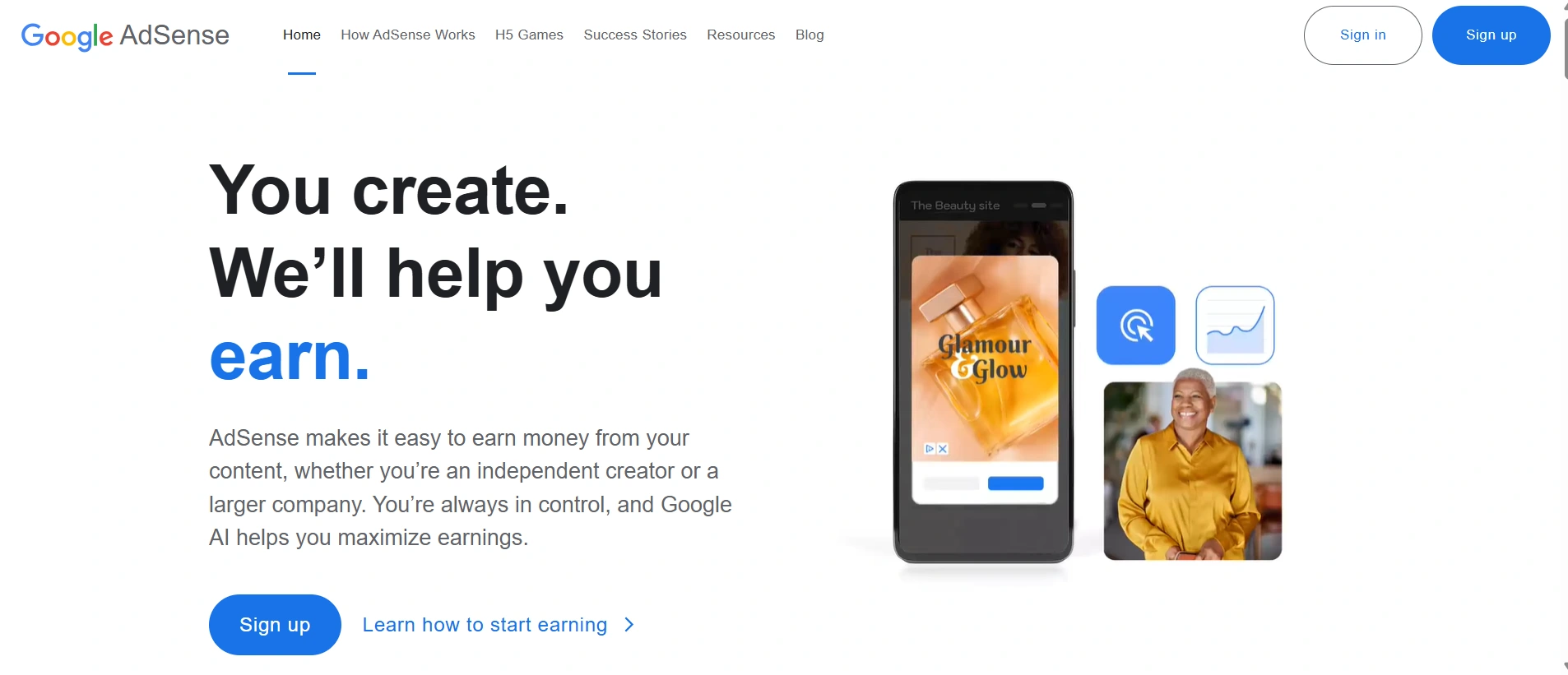
Google AdSense is the original and most trusted pay-per-click affiliate program. It’s been around since 2003 and still powers thousands of profitable blogs, especially those with strong SEO and steady traffic.
It’s run by Google, taps into Google Ads inventory, and delivers high-quality contextual ads that match your content and audience. You earn each time a visitor clicks one of those ads.
It’s not just for blogs—AdSense works on forums, niche content sites, tools, and even some YouTube channels (via YouTube Partner Program).
How It Works:
You apply with your website. If it meets Google’s quality standards, you get approved. Once approved, you paste their code, and AdSense takes care of serving and optimizing ads.
Ads appear as:
– Text links
– Display banners
– Responsive units
– In-feed and in-article ads
– Matched content units (for internal recirculation + monetization)
Why It’s Worth Joining:
– Massive advertiser pool = higher payouts per click
– Reliable tracking, smart targeting, and clean UI
– Great for evergreen content and blogs with consistent search traffic
– Works well with high-intent keywords (tech, finance, software)
Best For:
– Authority-style content websites
– Blogs with SEO-driven traffic
– Niches like finance, SaaS, tech reviews, and tutorials
– Sites that follow Google’s content and UX guidelines
Commission & Payouts:
– 70% rev share on content ads
– CPC varies based on niche, geo, and traffic quality
– High CPC niches (software, finance, insurance, B2B tech) can pay $1–$10+ per click
– Payout via bank transfer, Western Union, checks, or Wire
– Minimum payout: $100
– Payout frequency: monthly (Net30)
Pros:
– Trusted by everyone—advertisers and publishers
– Clean ad formats that don’t harm UX
– High CPC in premium niches
– Auto-ads available (for full automation)
– Deep reporting and testing features
– Works long-term if you follow the rules
Challenges:
– Strict approval—site must be well-designed, original, and useful
– Violation = instant ban (no second chances)
– Traffic from certain countries may earn less
– Needs consistent content and updates to perform well
– No push, pop, or aggressive monetization formats allowed
Pro Tip: Use AdSense alongside affiliate links in content, but separate them clearly. Also, blend ad units with your content’s style—avoid making them look like obvious ads. Higher CTR = higher earnings.
AdSense is still the gold standard for content monetization through PPC. It’s clean, scalable, and dependable. If your site checks Google’s boxes, this is hands down one of the most passive income-friendly PPC models out there. Just don’t try to game it—it’s Google.
2. Media.net
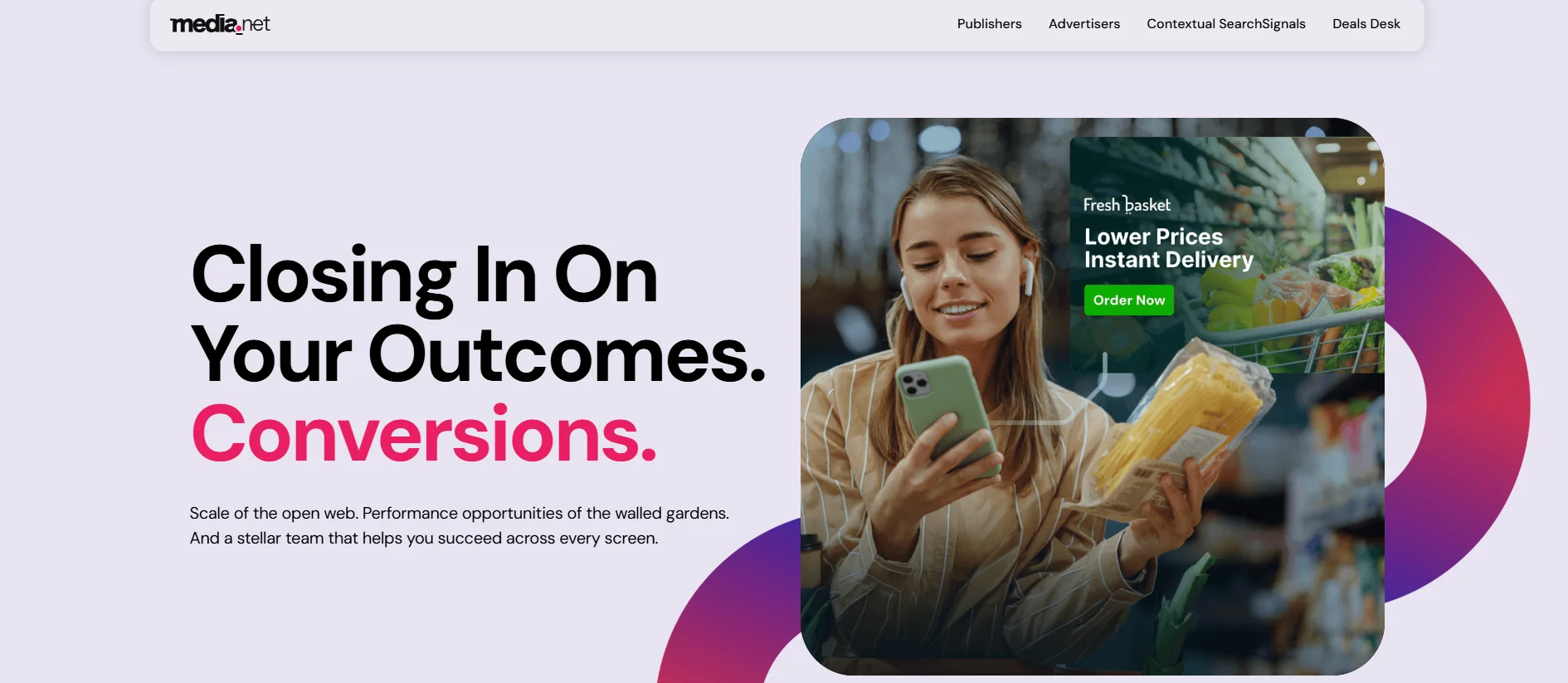
Media.net is one of the biggest contextual ad networks out there—backed by Yahoo and Bing. It runs a solid PPC model, where you earn money each time a user clicks on a relevant ad placed within your content.
It’s clean, fast, and perfect for content-rich sites in niches like tech, finance, and education.
It doesn’t rely on gimmicks or flashy formats. Instead, it focuses on showing highly targeted ads based on the user’s intent and your page’s content.
How It Works:
Once approved, you add their ad units—usually display or in-content boxes. These ads are keyword-matched to your page, so users are more likely to click. They look native, not disruptive. If someone clicks, you earn.
It’s ideal for sites that have solid written content, especially in English-speaking markets.
Why It’s Worth Joining:
– Contextual targeting = relevant ads users actually engage with
– High-quality advertisers from Bing/Yahoo ecosystem
– Smooth integration with WordPress and custom sites
– Works well alongside AdSense (if placed right)
– Better RPMs for tech, SaaS, B2B, and blog-style content
Best For:
– Affiliate marketers with content-heavy blogs
– Publishers in Tier 1 markets (US, UK, Canada)
– Those in tech, software, education, finance, or DIY
– Anyone looking for a reliable, AdSense alternative that pays per click
Commission & Payouts:
– CPC-based model (earn per click)
– RPMs vary, but solid if your traffic is from the right regions
– Minimum payout: $100
– Payout via PayPal and Wire Transfer
– Net30 schedule
Pros:
– Trusted, high-authority network
– Native-style ads that blend in well
– Contextual targeting boosts click-throughs
– Great dashboard and reporting tools
– Works across desktop and mobile
Challenges:
– Approval is strict—you need decent content and some traffic
– Doesn’t perform well with non-English or low-tier traffic
– $100 threshold is steep for beginners
– Not ideal for aggressive monetization tactics (like popups or redirects)
Pro Tip: To increase your earnings, place Media.net ads within or directly under your blog content, not just in the sidebar. Also, focus your articles on keywords that attract high-bid ads.
Media.net is a top-tier PPC affiliate option if your site’s clean, has strong content, and gets quality traffic. It’s not flashy or aggressive, but it pays consistently and treats publishers like partners.
If you’re building a serious affiliate site around content and want an alternative to AdSense with solid authority, this one’s a must-try.
3. PropellerAds
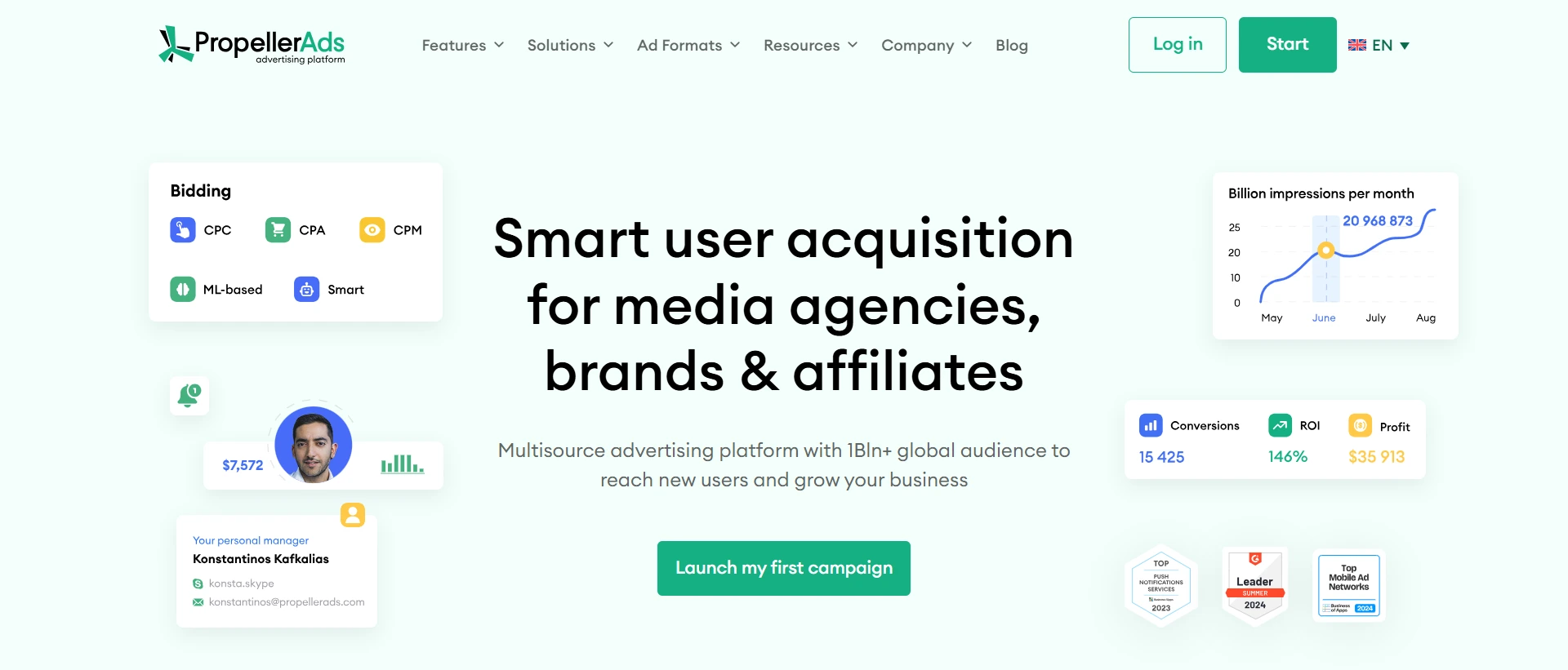
PropellerAds is a full-stack ad network known for monetizing every kind of traffic—even the stuff most networks don’t want.
Unlike Google AdSense or Media.net, this one’s made for affiliates, arbitrage players, and publishers who get non-Tier 1 traffic or want to mix multiple ad formats for higher revenue.
It supports both PPC and CPM models, with flexible ad units that can fit any content setup.
How It Works:
You register, get approved fast, and add their code. You can choose from ad types like:
– Push notifications
– Native banners
– Interstitials
– Onclick/popunder ads
– Direct links
Every click or impression can bring earnings. PropellerAds uses AI optimization to rotate and serve ads that get the best engagement based on your traffic source.
Why It’s Worth Joining:
– Monetizes global traffic, including Tier 2/3
– Ad formats are great for blogs, tools, download sites, and file-sharing traffic
– No need for massive traffic to start earning
– Fast approval, low entry bar
– Great for testing monetization on multiple niches and channels
Best For:
– Marketers with mixed traffic sources (SEO, social, email, paid ads)
– Sites that have traffic from Asia, Africa, or Latin America
– Affiliate blogs, freebie sites, and downloads
– Those testing microniches with small but consistent traffic
Commission & Payouts:
– CPC and CPM (depending on ad format)
– Push ads and interstitials can pay well per click
– Minimum payout: $5 (perfect for beginners)
– Payout via PayPal, Payoneer, Skrill, Wire
– Daily, Weekly, or Net30 payouts based on your account
Pros:
– Accepts nearly any type of traffic
– Fast sign-up and setup
– Works for niches AdSense won’t touch
– Low payout threshold
– High fill rate across countries and devices
– Real-time reporting and optimization
Challenges:
– Some ad types (like popunders) may annoy users
– Not ideal for luxury or premium content sites
– Less control over which advertisers appear
– Traffic quality affects payout rates heavily
– Can slow down your site if not implemented well
Pro Tip: Start with push notifications and native banners for better user experience. Avoid stacking too many aggressive formats unless you’re targeting specific geos that tolerate it (like gaming or entertainment).
PropellerAds is a strong PPC option for affiliate marketers with non-traditional traffic. It’s not fancy, but it gets the job done—especially if you’re experimenting with new niches or traffic sources that bigger ad networks ignore.
4. Adsterra
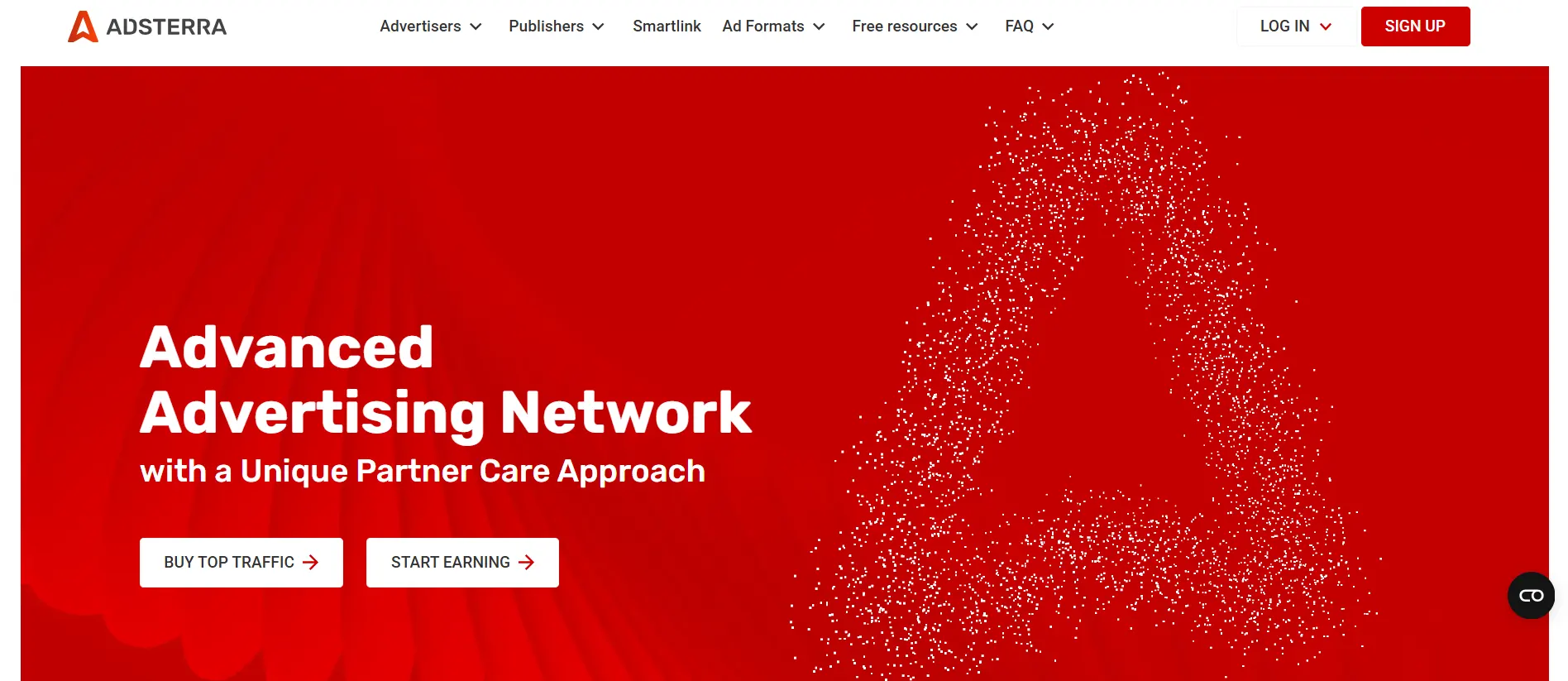
Adsterra is a well-known ad network that supports publishers and affiliates through multiple ad formats and monetization models—including PPC, CPM, and CPA.
It’s popular for its global reach, high fill rates, and fast-growing demand across non-English-speaking countries. If you’re running a site with mixed or international traffic, Adsterra is a solid option.
While many see it as a display ad alternative to AdSense, it’s also a strong platform for affiliates. You can promote offers from their Direct Affiliate Program and earn per click or per action depending on the campaign.
How It Works:
You add Adsterra ad tags or a smart code to your site. Then, based on your niche and traffic, their system displays ads—from banners and popunders to push notifications and social bars. You earn money based on how users interact with these ads—primarily per click (CPC) or per thousand views (CPM).
Adsterra also has a self-serve platform for affiliates where you can pick campaigns and promote them using your own landing pages, links, or ad creatives.
Why It’s Worth Joining:
– Diverse ad formats: From native ads and popunders to interstitials and direct links, you can test what fits best.
– High eCPM and CPC rates: Especially strong in entertainment, software, gaming, VPN, and adult niches.
– Instant approval: Unlike AdSense, you can start earning almost immediately.
– Anti-Adblock tech: Helps recover revenue lost from users running ad blockers.
– Real-time reporting: You see performance data instantly and can make fast decisions.
Best For:
– Sites with international or tier 2/3 traffic.
– Niche blogs focused on software, streaming, VPNs, gaming, or dating.
– Affiliates looking to monetize traffic with non-standard ad types.
– Publishers tired of AdSense rejections.
Commission & Payouts:
– CPC and CPM (varies by GEO and traffic quality).
– Payments via PayPal, Bitcoin, WebMoney, Paxum, Skrill, Bank Wire.
– Minimum payout is $5–$100, depending on method.
– Net15 and weekly payouts for trusted partners.
Pros:
– Easy setup with multiple monetization options.
– Higher tolerance for edgy or gray-area niches.
– Works well for mobile and desktop traffic.
– Affiliate network + publisher network in one platform.
– Referral program lets you earn extra by inviting others.
Challenges:
– Popunders and push ads can be intrusive—may hurt user experience if overused.
– Revenue varies a lot by GEO and niche—U.S. traffic earns more, of course.
– Some campaigns lean toward aggressive ads; always monitor what’s shown.
– Not ideal for ultra-clean, corporate, or health blogs.
Pro Tip: Use social bar ads and native banners—they blend better with your content and get decent CPC without annoying users. Also, test their affiliate dashboard—it gives access to exclusive campaigns that aren’t shown elsewhere.
Adsterra is ideal if you’re monetizing a tech or niche blog with mixed traffic sources. It’s flexible, fast to start, and gives you room to experiment with different ad styles.
If you’re looking for more control and higher returns than AdSense offers—especially in affiliate-focused verticals—Adsterra should be high on your list.
5. Infolinks

Infolinks is one of the OGs in the PPC ad space—but it’s still highly relevant, especially for bloggers and publishers who don’t want their site to look like a clickbait jungle. Instead of pushing flashy banners, Infolinks slips ads into your content.
When a reader hovers or clicks on linked keywords, a small ad bubble shows up. This means the ad is triggered by genuine interest, not just a random impression.
How It Works:
It scans your site content using contextual targeting. Let’s say you write about smartwatches. Infolinks will automatically hyperlink words like “smartwatch,” “fitness tracker,” or “heart rate monitor,” and serve relevant ads tied to those terms. You don’t pick keywords manually—it’s all handled by their algorithm.
You get paid per click, but since the ads are native and non-intrusive, users are more likely to interact naturally. You also don’t need banner space or redesign your layout.
Why It Works Well for Content Creators:
If your site is article-based—think blogs, reviews, guides—Infolinks just fits. It doesn’t break your theme or slow down your site. You install a simple code, and ads start showing in minutes.
It also plays nice with AdSense, so you can run both without breaking any rules. That gives you more flexibility to stack your earnings.
More on Commission Rates:
Payouts vary, but here’s the kicker:
If your content targets high-paying verticals like tech, software, finance, or education, you can earn more per click than with traditional display ads. It’s not uncommon to hit $1+ CPC in these niches.
But for general lifestyle or hobby traffic, expect lower earnings—maybe $0.05 to $0.30 per click.
Ad Formats You Can Use:
– InText – keywords inside articles (their bread and butter)
– InFold – banner-style at the bottom of the screen
– InFrame – vertical banners for widescreen traffic
– InTag – tag-based ad units
– InArticle – native ads inserted between paragraphs
Each format can be turned on/off from the dashboard. You don’t need all of them running at once.
Who Should Use It:
– Small to mid-sized publishers with consistent blog traffic
– Niche sites focused on how-tos, comparisons, or news
– Review blogs with longer time-on-page
– Sites with global audiences (Infolinks has worldwide demand)
Drawbacks to Know:
– Low-paying if your niche isn’t in demand
– Ads may feel repetitive if overused
– $50 payout threshold is a bit high for small blogs
– CPC isn’t always transparent—you have to test and optimize
Infolinks isn’t flashy, but it’s steady. It works behind the scenes and doesn’t kill your bounce rate. For tech micro-niches—especially ones focused on content and not product-heavy affiliate pages—it can be a nice extra stream.
6. Revcontent
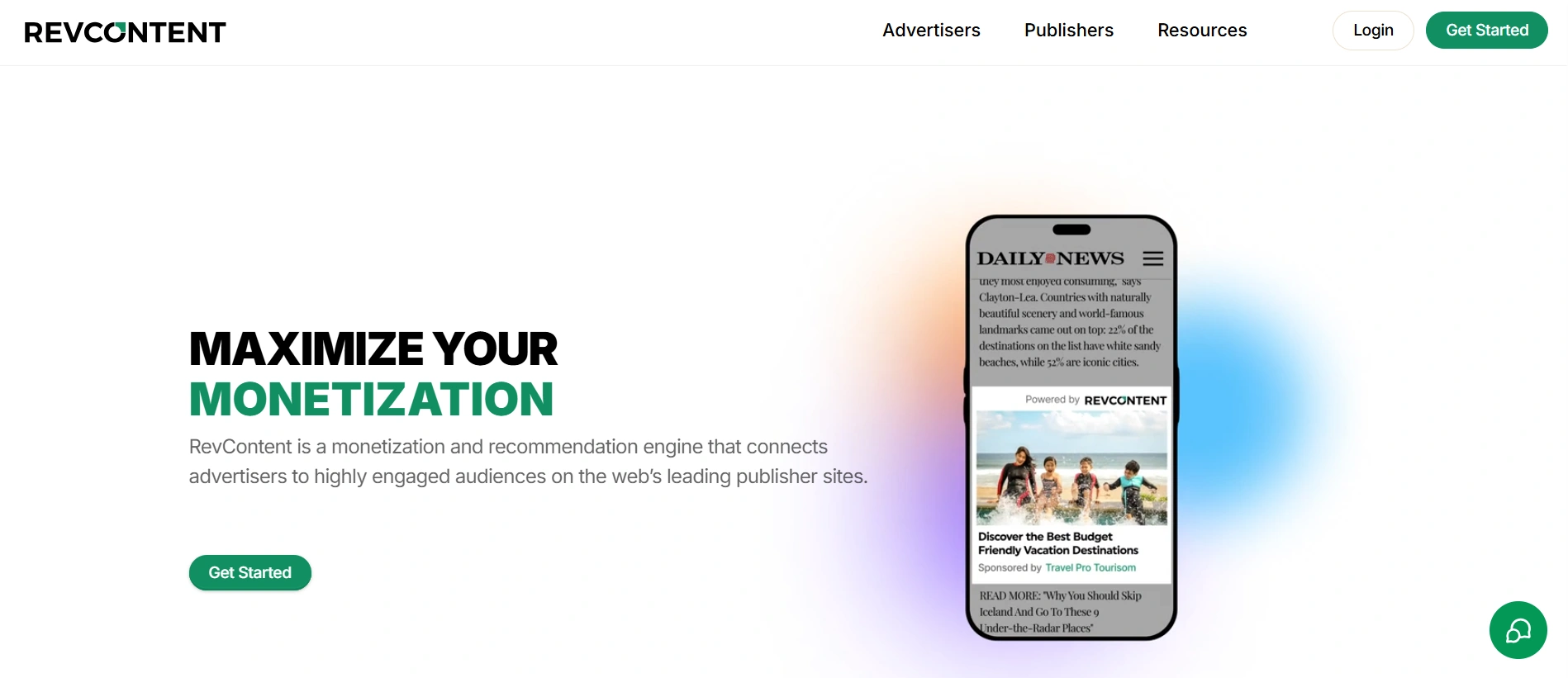
RevContent is a native advertising network. That means it blends ads into your content so they look like part of your site. Think of those “You may also like” or “Trending on the web” boxes with eye-catching headlines and thumbnails.
Unlike banner-heavy platforms, Revcontent focuses on engagement. The better your content and audience quality, the better your payouts.
Why It Stands Out:
This is not for beginners. Revcontent is picky. They want sites with strong content, good traffic numbers, and a clean design. But if you get approved, you’re in front of premium advertisers with high CPCs—especially in niches like:
– Tech
– Finance
– Health
– Software
– Business tools
How It Works:
Once approved, you place native ad widgets in strategic spots—below posts, in sidebars, or inside your articles. These widgets show headlines and thumbnails that drive clicks. When a visitor clicks one, you get paid. No sale required.
You’re paid per click, but with Revcontent’s advertiser base, the CPCs are often much higher than with standard networks like AdSense.
Real Numbers (based on niche and quality):
– Low-tier niches: $0.10 – $0.40 CPC
– Tech, Finance, SaaS: $0.60 – $2+ CPC
– Top-tier traffic (US, UK, CA): best rates
– CTRs are solid if your content blends well with the ads
Key Features:
– Clean, fast-loading native ads
– Full control over ad appearance and placement
– Competitive RPMs (can hit $10–$30+ with high-quality traffic)
– Can be used alongside other affiliate content
Best For:
– Niche affiliate blogs with consistent traffic
– Comparison or product round-up content
– Content-heavy tech blogs (AI tools, cybersecurity, gadgets, software)
– Sites getting 50K+ monthly visits (they can approve less, but that’s their comfort zone)
Payment Details:
– Net 30 payment terms
– $100 minimum payout
– Pays via PayPal or Wire
Challenges to Know:
– Approval can be tough—low-quality content won’t pass
– You must optimize placement, or you’ll kill your UX
– Too many ad widgets = bounce rate issues
– Doesn’t perform well on short-form or thin content
Pro Tip: Revcontent plays well with review posts and listicles. For example, if you’re ranking for “Best AI tools,” those end-of-article native ads drive extra clicks. So while you push affiliate links in the content, Revcontent adds passive income underneath.
Revcontent is a high-earning option—but only if you’re ready for it. It’s not plug-and-play like Infolinks or AdSense. But once set up, it quietly generates income from readers who are done with your main content.
It’s ideal for tech blogs with meaty articles, good traffic flow, and an audience hungry for more tools, hacks, and products.
7. BidVertiser
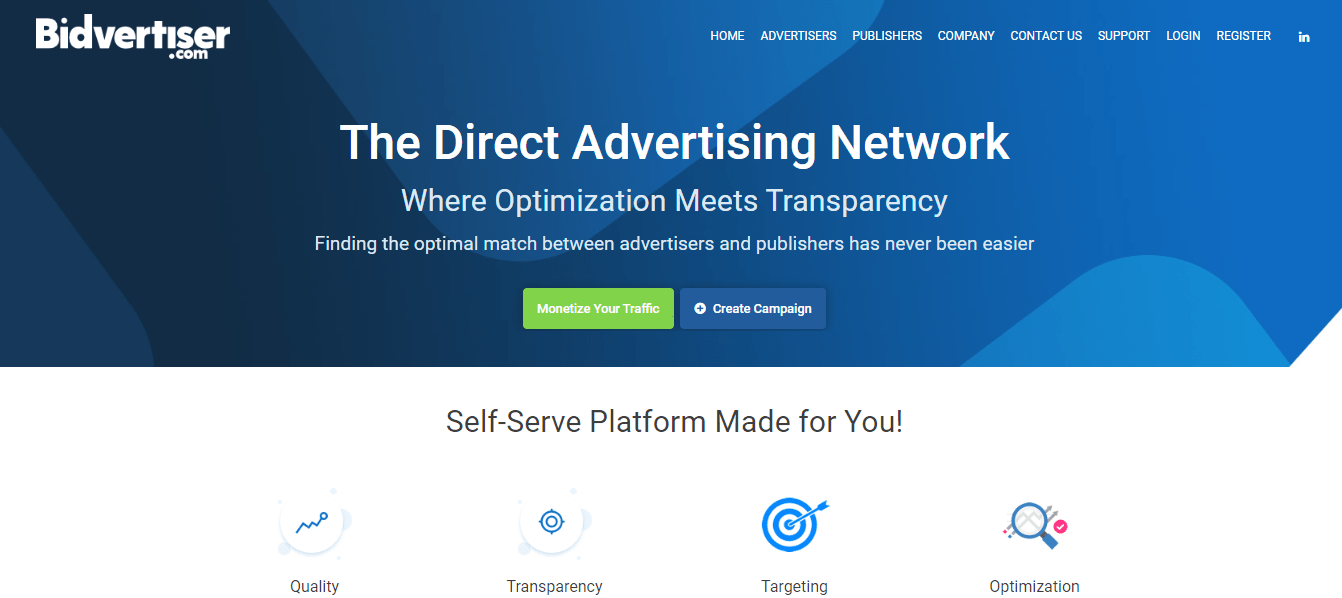
BidVertiser is a mix of classic pay-per-click and a bit of performance-based juice. You earn per click, but if that click turns into a conversion on the advertiser’s side, you get a bonus. It’s one of the few hybrid models that rewards both volume and quality.
It’s been around for a while, and while not as fancy as AdSense or as selective as Revcontent, it’s surprisingly solid—especially for smaller sites or traffic sources that others might reject.
How It Works:
You add ad units to your site—text ads, banners, pop-unders, sliders, etc. When a visitor clicks, you earn money. If the visitor buys something or signs up on the advertiser’s end, you get extra.
Think of it as PPC with a CPA side hustle.
Why It Works:
– Accepts a wide range of traffic sources
– Ideal for international or Tier 2/3 traffic
– Has automatic and manual ad optimization
– Gives more flexibility if your traffic isn’t Google-friendly
Typical CPC Rates:
– $0.03 to $0.10 for global/general traffic
– $0.20 to $1+ for niche and Tier 1 (US, UK, CA)
– Bonus conversions: varies by campaign (some as high as $5–$20)
Best Niches:
– Software and downloads
– Tools and utilities
– Mobile apps
– Adult-safe niches
– Anything with high click intent (how-to, giveaways, etc.)
Key Features:
– Multiple ad formats (banners, sliders, pop-unders, etc.)
– Built-in ad customization tools
– Real-time stats
– Hybrid payout model (PPC + bonus CPA)
– Accepts traffic others might reject
Payment Details:
– $10 minimum payout (super low)
– Weekly or monthly payouts
– PayPal, Wire, Bitcoin
Challenges to Consider:
– Lower CPC than Revcontent or AdSense (especially for US traffic)
– Pop-unders and sliders can annoy users if overused
– Ad quality varies—some creatives feel outdated
– Not ideal for premium brand sites
Pro Tip: Use BidVertiser on pages that don’t convert well for your affiliate offers. Let those “leaky” pages earn through clicks instead of trying to force a sale.
Example: A “Top 5 PDF Editors” post that gets traffic but few clicks on your affiliate links? Drop a BidVertiser widget in the sidebar or below the fold to monetize idle traffic.
BidVertiser isn’t glamorous—but it works. It’s a plug-and-earn model with little fuss and steady income. Not your main moneymaker, but perfect as a backup or filler for tech sites, tool roundups, or app-related posts.
8. AdThrive (Now Raptive)
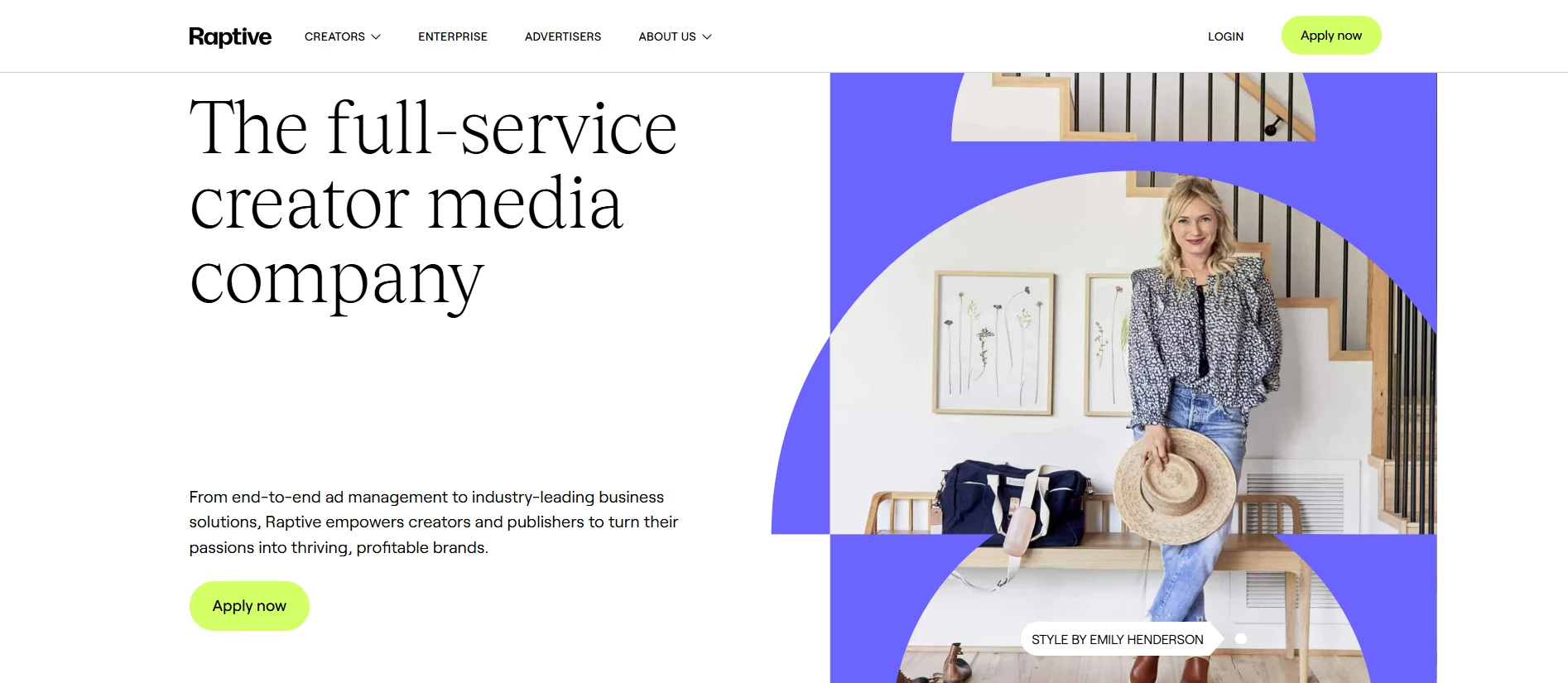
AdThrive is a top-tier ad management network. It’s built for established blogs and authority sites that pull in solid monthly traffic. Think of it as a concierge-level version of AdSense—with better payouts, hand-picked advertisers, and a team that helps you optimize every ad spot.
They don’t just throw ads on your site. They work with you to boost earnings without killing your user experience.
How It Works:
AdThrive runs programmatic ads (CPC, CPM, and hybrids) using Google Ad Manager and direct advertiser deals. Their team sets up and manages everything—from layout testing to ad strategy.
You get paid for impressions and clicks, but the big money often comes from CPM-based display ads shown to US-based traffic.
Why It Works:
– Extremely high RPMs for US traffic
– Better ad quality and brand safety
– White-glove support (real people who guide you)
– Optimized for mobile and desktop
– Tailored ad placements to boost performance
Requirements to Join:
– 100,000 monthly pageviews (must-have)
– Majority of traffic from US, UK, CA, or AU
– Clean, original content with solid engagement
– Must be on WordPress or a CMS they support
Typical Earnings:
– $15–$30+ RPMs for US traffic (niche dependent)
– Some tech sites report $3,000–$6,000+ per month at scale
– Better long-term revenue than just PPC (hybrid models help)
Best Niches:
– Tech tutorials and guides
– Product reviews
– DIY and how-to content
– Personal finance + gadgets
– Any niche with high-value US traffic
Payment Details:
– Net 45 (you get paid 45 days after end of month)
– $25 minimum payout
– PayPal, Wire Transfer, Check
Pros:
– High payout rates
– Set-it-and-forget-it setup once optimized
– Great for scaling income with existing traffic
– Works well with other affiliate links
– Dedicated support team
Challenges:
– Strict entry requirements
– Not for small or new sites
– Can’t customize ad layout too much
– May slow down page speed slightly if not optimized
Pro Tip: Pair AdThrive with your existing affiliate strategy. Use it to monetize traffic from top-funnel posts like “Best Smartwatches for Beginners” or “AI Tools You Should Know.” These attract big traffic but don’t always convert directly.
Let AdThrive do the heavy lifting on the monetization side.
If you’ve got the traffic, AdThrive is one of the best ways to turn eyeballs into income—without selling a single product. It’s not for everyone, but for established sites, it’s a passive income engine.
9. Ezoic Ads
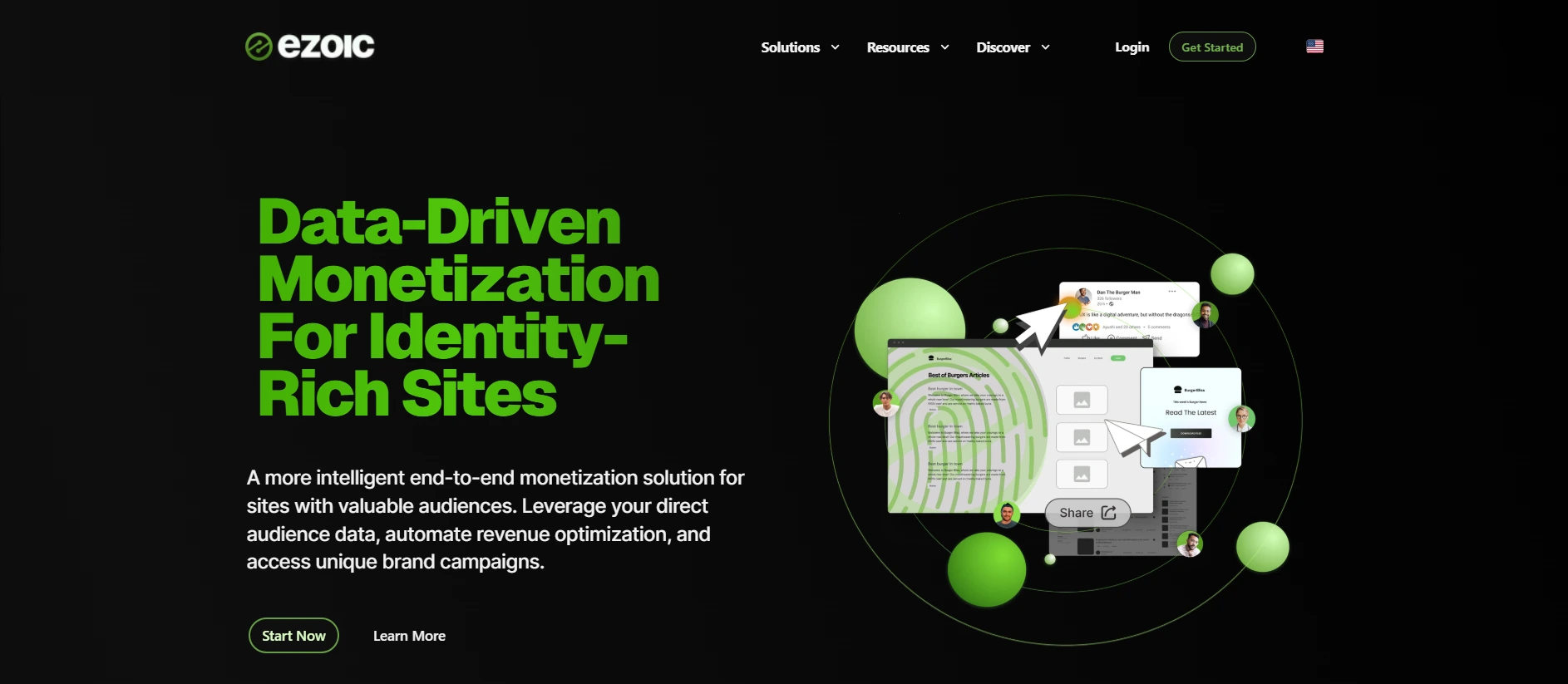
Ezoic is an advanced ad network that uses artificial intelligence to optimize ad placements and maximize revenue. Think of it as the smart engine behind your site’s monetization strategy.
Ezoic focuses on improving user experience and ad performance simultaneously, ensuring that your ads don’t just make money but also enhance the visitor experience. This is crucial for maintaining your audience while boosting your earnings.
Ezoic offers both CPC (Cost Per Click) and CPM (Cost Per Thousand Impressions) models, providing a hybrid approach that adapts to your traffic and audience behavior.
How It Works:
Ezoic uses machine learning to test multiple ad layouts, sizes, and placements across your site. The AI monitors how users interact with ads—whether they click, ignore, or engage with the content around them—and then continually adjusts to maximize revenue.
The goal is to display the right ads, at the right time, without hurting user experience.
Once set up, you can choose from a range of ad formats, including display ads, native ads, and video ads.
Why It Works:
– AI-powered optimization: Ezoic automatically fine-tunes your ad placements for better performance over time.
– High revenue potential: By optimizing both ad layouts and targeting, it can boost your ad revenue compared to traditional methods.
– Non-intrusive ad placements: It finds the balance between ad visibility and user experience, avoiding overwhelming your audience.
– Multiple monetization models: Works on both CPC and CPM models, allowing flexibility depending on your traffic type.
– Integration with Google AdSense: Ezoic partners with Google AdSense and other ad providers, giving you access to a wide pool of advertisers.
Requirements to Join:
– At least 10,000 monthly pageviews (but sites with more traffic tend to see better results).
– Content-rich site with consistent traffic.
– Traffic from various sources (not just organic).
– Ability to run the Ezoic WordPress plugin or use Ezoic’s integration tools.
Typical Earnings:
– Earnings can vary based on your site’s traffic, content type, and user interaction, but typical RPMs (Revenue Per Thousand Impressions) range from $5 to $20 for well-optimized sites.
– Some tech-focused blogs report $2,000 to $4,000/month with steady traffic.
– The longer you use Ezoic, the better the AI optimizes your revenue stream.
Best Niches:
– Technology, especially sites focusing on reviews, tutorials, or product comparisons.
– DIY and how-to content (these often generate high-value traffic).
– Lifestyle and personal finance, where users are more likely to engage with ads.
– News, entertainment, and niche media sites.
Payment Details:
– Net 30 (payment made 30 days after the month ends).
– Minimum payout threshold is $20.
– Multiple payment options including PayPal and Bank Transfer.
Pros:
– AI-powered optimization helps boost revenue without constant manual tweaking.
– Ability to run multiple ad formats and monetize in different ways.
– Non-intrusive ad layout options that improve user experience.
– Works well with Google AdSense and other ad networks, helping you maximize earnings across the board.
– Excellent support and resources for setup and optimization.
Challenges:
– Requires a bit of setup and testing to get the best results.
– Might not generate substantial earnings for sites with less traffic.
– AI optimization takes time—results improve gradually as the AI gathers data.
– Some users report a slight dip in ad revenue during the initial testing phase.
Pro Tip: Ezoic excels with higher traffic sites. If you’re growing a tech blog, use Ezoic in combination with your affiliate strategy to boost overall earnings. By blending PPC and affiliate revenue, you’re covering more revenue streams while the AI optimizes your ad placements.
Ezoic is a top choice for tech sites looking to optimize their ad revenue. If you have the traffic and are ready to let AI take the wheel, Ezoic can significantly increase your earnings, with less effort on your part. It’s a great choice for site owners who want to scale efficiently.
10. RevenueHits
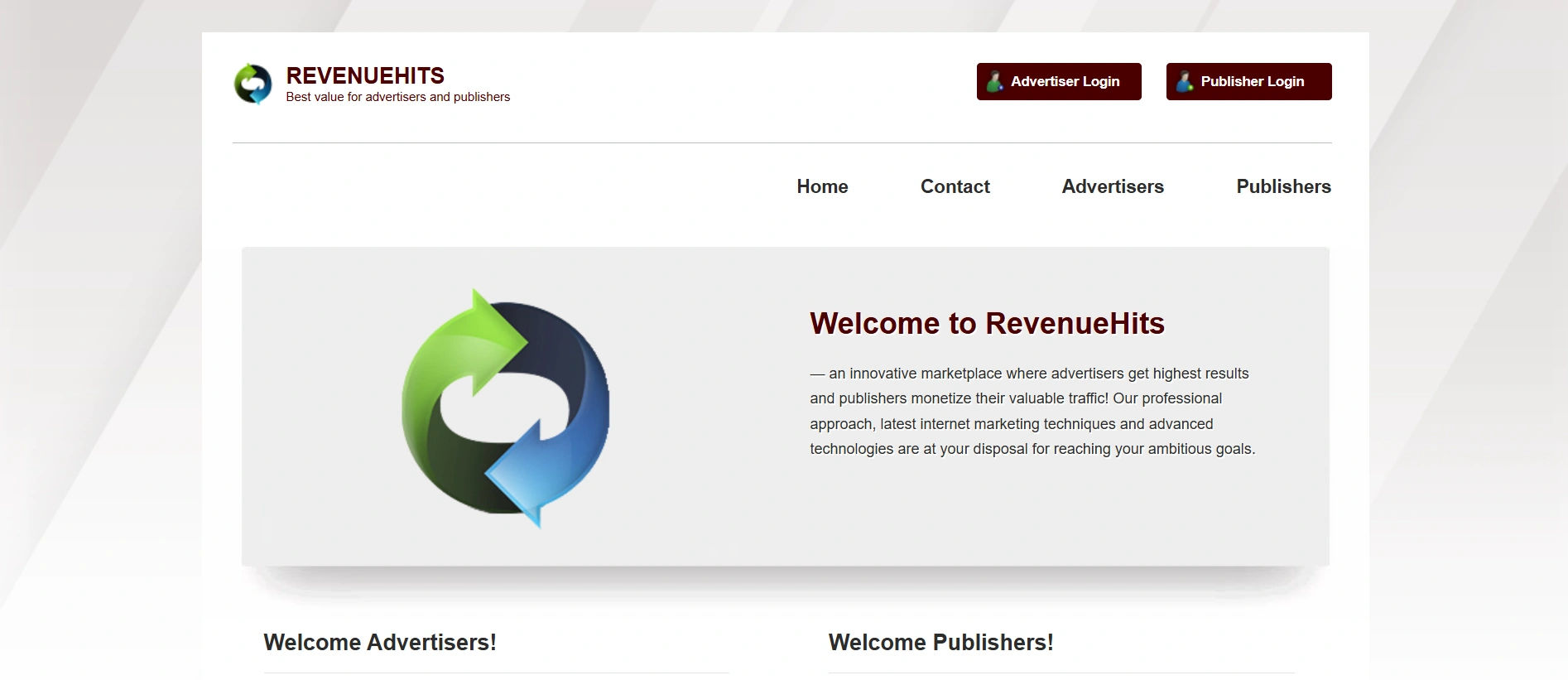
RevenueHits is often misunderstood. Many think it’s strictly CPA-based, but that’s only part of the picture. It actually uses contextual and geo-targeting tech to serve ads based on what works best—whether that’s PPC, CPM, or CPA.
It’s not a traditional PPC-only platform, but you can still earn per click depending on the campaign and your traffic type. And the beauty of it? You don’t have to wait for users to buy something. You earn from actions like signups, app installs, or even clicks on well-optimized ads.
How It Works:
You place ad units—like banners, popunders, or sliders—on your site. Their system automatically tests different formats and offers to find what converts. Based on user behavior, you earn money for actions or engagements, which often includes clicks, especially on their smart links and direct campaigns.
They also offer monetization tools for affiliates like: – Direct links – XML feeds – Custom widgets – Smart targeting for mobile, desktop, and tablets
Why It’s Worth Joining:
– Automatic optimization: Their system adjusts ads to fit your layout and traffic behavior.
– Global coverage: Works with traffic from almost anywhere, not just tier 1 countries.
– No product pushing: You earn from simple actions—not just purchases.
– Easy approval: Great for new sites or those rejected by AdSense.
– Flexible ad types: From standard banners to more aggressive formats if you want them.
Best For:
– Bloggers who want to earn without driving sales.
– Traffic sources from varied countries (especially tier 2/3).
– Affiliates with download, utility, or content-heavy sites.
– Anyone who doesn’t mind experimenting with different ad styles.
Commission & Payouts:
– Earnings come from CPA, CPC, and CPM (depends on ad + traffic).
– Payout via PayPal, Payoneer, Wire Transfer, Bitcoin, and others.
– Minimum payout: $20–$500 (based on method).
– Net30 schedule, but reliable and consistent.
Pros:
– Doesn’t rely on sales to pay you.
– Broad ad coverage and good fill rates.
– Strong geo-targeting and optimization engine.
– Customizable tools for affiliate-style promotion.
– Allows pop and interstitial formats for aggressive monetization.
Challenges:
– Ads can sometimes look spammy or aggressive—requires moderation.
– EPC (earnings per click) isn’t consistent—it shifts based on campaign types.
– UI feels outdated compared to newer networks.
– Not ideal for clean, corporate, or finance-focused blogs.
Pro Tip: Test direct links or use them in lower-traffic pages to avoid cluttering your best content. Pair with another clean network like AdSense or Infolinks for balance.
RevenueHits isn’t a one-size-fits-all network—but it works, especially if you’ve got international traffic or content that doesn’t convert well through pay-per-sale.
With some patience and testing, you can build a steady income stream with PPC and CPA hybrid earnings. It’s worth trying if you’re tired of waiting on product commissions and want faster wins.
How to Maximize Earnings from PPC Affiliate Programs
Making money with PPC isn’t about slapping ads everywhere and hoping for clicks. It’s about strategy, targeting, and quality. You don’t need millions of pageviews—just the right kind of traffic and smart ad execution.
Here’s what actually moves the needle:
1. Pick the Right Traffic Channels
Not all traffic pays the same.
Organic search traffic from Google tends to convert best—especially if your content targets high-intent keywords.
Long-form guides, reviews, tutorials, and comparison pages do great here.
- SEO brings consistent, warm traffic. But it takes time.
- Paid ads can work, but you’ll need to be razor-sharp with costs.
- Social media can give bursts, but ad blindness is higher.
Use analytics to track which source brings quality clicks, not just volume.
2. Ad Placement Matters More Than You Think
Above the fold still wins.
Place ads where users naturally pause—after intros, between sections, and near CTAs. Don’t stuff. Just guide the eyes.
Responsive units and native formats blend best. Don’t force banners that look like early 2000s popups.
Test different layouts. A small shift in placement can double your CTR overnight.
3. Match Ad Format With Content Type
Don’t run video ads on a text-heavy tutorial page.
For blogs, go with in-article or in-feed ads.
For tools or calculators, sidebars or sticky footer ads convert better.
For forums, use matched content or contextual links.
Context is everything. Let the content guide the ad style.
4. Clean Traffic Only
Never buy cheap clicks.
Networks know. Bots, junk traffic, and click farms will either get you banned—or destroy your earnings. Fast.
Focus on real users from countries your PPC program pays well for. That’s usually US, UK, CA, AU, and some EU regions.
Install anti-bot filters. Use tools like Cloudflare and traffic monitoring plugins if needed.
5. Monitor, Adjust, Repeat
Your job doesn’t end after placing the ads.
Check reports. Test formats. Remove what underperforms. Increase what works. Rinse and repeat.
Most programs let you A/B test layouts and styles. Use it. One tweak could mean the difference between $10/month and $200/month.
6. Don’t Mix Conflicting Monetization
Running aggressive affiliate banners next to PPC ads can confuse users—and hurt both conversion and clicks.
If you do both, separate them by intent. Use content clusters: one for PPC-friendly info content, another for affiliate-heavy reviews.
Also, avoid clutter. Too many ads kill trust. Fewer, smarter placements win.
My final thought on this: PPC affiliate marketing is a long game. The money builds slowly, but steadily—if you treat your traffic and layout with care. Nail the basics, then fine-tune. That’s how pros build quiet, stable income month after month.
Here’s a full version of Part 6: Common Mistakes to Avoid in PPC Affiliate Marketing, written in a natural flow without separate sections, as requested:
Common Mistakes to Avoid in PPC Affiliate Marketing
There’s a lot of potential in PPC affiliate marketing—but many beginners blow it by rushing in without a real plan.
One of the biggest mistakes is relying only on PPC income while ignoring other ways to make money. PPC earnings can fluctuate. If it’s your only stream, you’re walking a tightrope with no net. Add affiliate links, info products, email funnels—something else to balance things out.
Another big mistake is breaking the rules of your ad network. It’s tempting to click your own ads, use shady pop-ups, or try tricks that boost clicks fast. But networks are smarter than you think. Violating policies—even once—can get you banned, and when that happens, you don’t get a second shot. Always follow the rules. Stay clean. Long-term money needs long-term trust.
Poor site optimization is another silent killer. Slow load times, weird layouts, or cluttered pages drive users away before they even see your ads. If your bounce rate is high, your earnings will be low. Make your site easy to read, fast to load, and mobile-friendly. Keep content sharp and well-structured—ads perform better when users stick around.
Also, don’t ignore your analytics. If you’re not tracking what works and what flops, you’re flying blind. You’ll end up wasting time on formats or traffic that don’t convert. Smart publishers look at heatmaps, scroll depth, and click-through rates. Then they adjust, test again, and improve bit by bit.
Finally, stop chasing high CPC keywords just for the payout. If your content doesn’t match the intent, the ad won’t click. Focus on relevance. Match your audience’s interest with the ad topic. Relevance always beats payout in the long run.
Avoiding these mistakes won’t guarantee overnight success, but it keeps your income stable, your accounts safe, and your site ready to grow. Most people quit because they go too fast. Play the long game instead.
Conclusion
The best pay-per-click affiliate marketing programs don’t just pay—they scale with smart effort. Focus on trusted networks, experiment with ad placements, and drive traffic that actually clicks.
With the right mix of strategy and patience, these programs can bring in steady income without waiting on sales to convert. Start simple, test often, and grow from what works.
Frequently Asked Questions
What is PPC affiliate marketing, and how is it different from other models?
PPC affiliate marketing pays you when someone clicks on an ad, not when they make a purchase. Unlike pay-per-sale (where you only earn if the user buys something), PPC rewards you just for driving traffic. It’s ideal for sites with good traffic volume but not necessarily high buyer intent. You focus more on user engagement than conversions.
Can I make a full-time income from PPC affiliate programs?
Yes, but it depends on your traffic quality, niche, and monetization strategy. PPC pays less per action than pay-per-sale, so volume matters. High CTR (click-through rate), relevant content, and using top-tier ad networks like AdSense or Media.net increase your chances. Many full-time bloggers and publishers use PPC as part of a broader income mix—ads, affiliates, sponsorships, etc.
What kind of websites work best with PPC affiliate marketing?
Content-heavy sites that attract a steady flow of targeted visitors do best. Blogs, news sites, niche tutorials, or review platforms with organic search traffic tend to perform well. Sites in finance, tech, health, and education often have higher CPCs (cost per click). If your site educates, informs, or solves a problem, it can work.
Are there risks involved with PPC affiliate marketing?
Definitely. Click fraud (accidental or intentional), violating ad policies, or driving low-quality traffic can get you banned. Many ad networks are strict—especially Google AdSense. Another risk is revenue instability. Earnings can drop due to seasonal trends, algorithm updates, or advertiser budget cuts. You need to follow the rules and diversify your income streams.
How do I get approved by top PPC affiliate networks?
Ad networks look for clean, original content and real human traffic. Your site should have a clear niche, privacy policy, about page, and fast loading speed. Avoid spammy content, adult material, or thin pages. Google AdSense is very picky, but networks like PropellerAds and RevenueHits are more beginner-friendly if you’re just starting.



